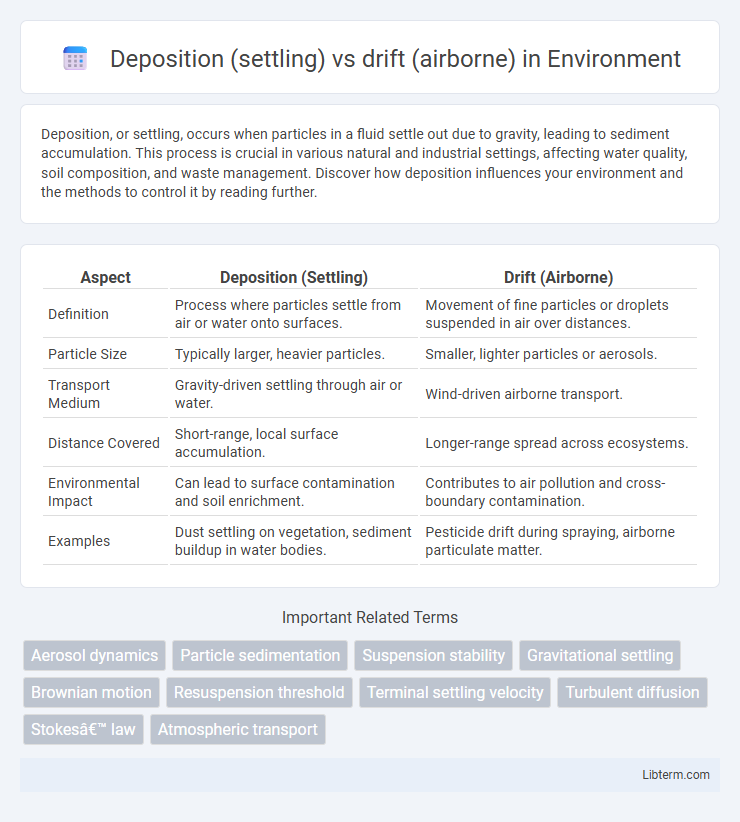Deposition, or settling, occurs when particles in a fluid settle out due to gravity, leading to sediment accumulation. This process is crucial in various natural and industrial settings, affecting water quality, soil composition, and waste management. Discover how deposition influences your environment and the methods to control it by reading further.
Table of Comparison
| Aspect | Deposition (Settling) | Drift (Airborne) |
|---|---|---|
| Definition | Process where particles settle from air or water onto surfaces. | Movement of fine particles or droplets suspended in air over distances. |
| Particle Size | Typically larger, heavier particles. | Smaller, lighter particles or aerosols. |
| Transport Medium | Gravity-driven settling through air or water. | Wind-driven airborne transport. |
| Distance Covered | Short-range, local surface accumulation. | Longer-range spread across ecosystems. |
| Environmental Impact | Can lead to surface contamination and soil enrichment. | Contributes to air pollution and cross-boundary contamination. |
| Examples | Dust settling on vegetation, sediment buildup in water bodies. | Pesticide drift during spraying, airborne particulate matter. |
Introduction to Deposition and Drift
Deposition refers to the settling of pesticide particles or droplets onto surfaces such as plants, soil, or water after application, influenced by factors like droplet size and wind speed. Drift describes the airborne movement of these particles away from the target area, primarily caused by wind and inappropriate spray techniques. Understanding the dynamics of deposition and drift is essential for optimizing pesticide efficiency and minimizing environmental contamination.
Defining Deposition (Settling)
Deposition (settling) refers to the process where airborne particles, pollutants, or aerosols gradually fall out of the atmosphere and accumulate on surfaces due to gravity and other forces. This contrasts with drift (airborne), where particles remain suspended and are transported by wind over varying distances. Understanding deposition is crucial for assessing pollutant distribution, environmental contamination, and exposure risks in air quality studies.
Understanding Drift (Airborne Movement)
Drift refers to the airborne movement of particles or droplets carried by wind or air currents over varying distances, significantly influenced by factors such as particle size, wind speed, temperature, and humidity. Unlike deposition, which involves particles settling onto surfaces due to gravity, drift can lead to unintended distribution of pesticides, pollutants, or other airborne contaminants beyond the targeted area. Understanding drift dynamics is crucial for minimizing environmental impact and improving the precision of applications in agriculture and industrial processes.
Key Differences Between Deposition and Drift
Deposition refers to the settling of airborne particles or droplets onto surfaces due to gravitational forces, primarily affecting soil, water, and vegetation within close proximity to the source. Drift involves the airborne movement of fine particles or droplets carried by wind over varying distances, potentially impacting areas far from the original release site. Key differences include distance traveled, with deposition occurring near the source, and particle size, as drift generally involves finer particles capable of being transported by atmospheric conditions.
Factors Influencing Deposition
Factors influencing deposition include particle size, shape, and density, which determine how quickly particles settle out of the air. Atmospheric conditions such as wind speed, temperature, and humidity play a crucial role in the rate of settling, with calm, cool, and moist environments enhancing deposition. Surface characteristics like roughness and vegetation also affect particle accumulation by providing surfaces for particles to adhere to, contrasting with drift where particles remain airborne and travel longer distances.
Factors Affecting Drift
Drift in airborne particles is influenced by wind speed, temperature, humidity, and particle size, with smaller particles traveling farther due to their lower settling velocity. Deposition or settling occurs more rapidly under calm conditions and larger particle size, as gravity overcomes aerodynamic forces. Vegetation, topography, and atmospheric stability also significantly affect drift by altering airflow patterns and particle dispersion.
Environmental Impacts of Deposition
Deposition, the settling of airborne particles onto surfaces, significantly contributes to soil and water contamination, affecting ecosystems and human health by introducing toxic metals, pesticides, and particulate matter. This process alters nutrient balances in soil and water bodies, leading to eutrophication and habitat degradation, which disrupts biodiversity and agricultural productivity. Unlike drift, which disperses pollutants over wide areas temporarily, deposition causes long-term accumulation and localized environmental damage, necessitating targeted remediation strategies.
Environmental Impacts of Drift
Environmental impacts of drift include contamination of non-target areas, harming sensitive ecosystems and agricultural crops due to airborne pesticide particles traveling beyond application sites. Drift contributes to air and water pollution by depositing chemicals on soil and water bodies, disrupting aquatic life and reducing biodiversity. Mitigating drift through buffer zones and precision application technology is essential to protect environmental health and maintain ecosystem balance.
Practical Examples in Real-World Scenarios
Deposition occurs when particulate matter, such as dust or pollen, settles onto surfaces like soil or water bodies due to gravity, exemplified by ash layers after a volcanic eruption or soot accumulation near industrial sites. Drift involves airborne particles like pesticide droplets carried by wind during agricultural spraying, potentially affecting neighboring crops or water sources. Understanding these processes aids in environmental management, for instance, reducing pesticide drift to protect ecosystem health and ensuring accurate air quality monitoring through deposition analysis.
Strategies to Minimize Drift and Enhance Deposition
Effective strategies to minimize drift and enhance deposition include adjusting spray nozzle selection for larger droplet sizes, optimizing application timing to avoid high winds or thermal inversion conditions, and implementing buffer zones around sensitive areas. Utilizing precision application technologies such as GPS-guided equipment and electrostatic sprayers improves droplet targeting and deposition accuracy. Proper calibration of spray pressure and maintaining equipment in good condition further reduce drift potential while maximizing the amount of active ingredient reaching the target surface.
Deposition (settling) Infographic

 libterm.com
libterm.com